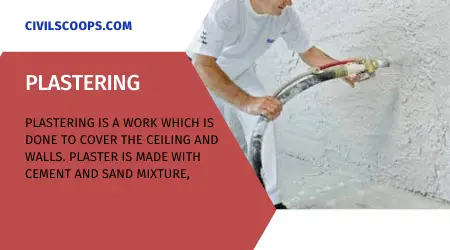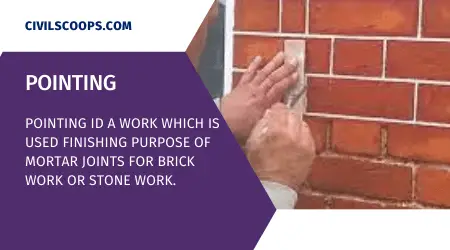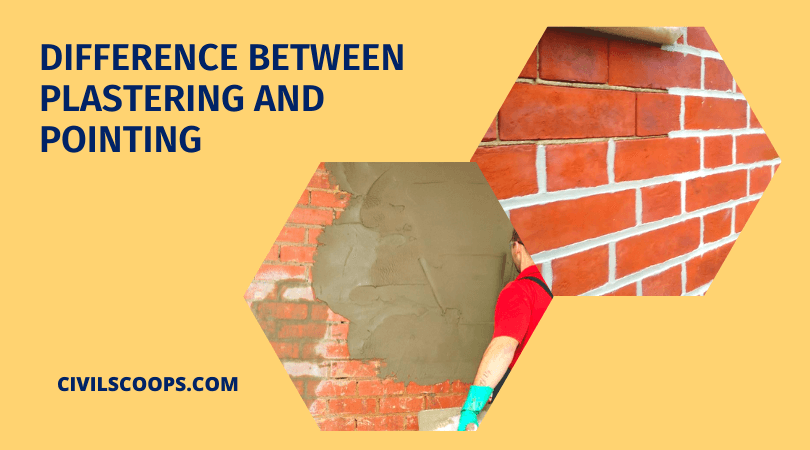What Is Plastering | What Is Pointing | Difference Between Plastering and Pointing |
Table of Contents
Introduction of Plastering and Pointing
- Basically, we know that a cement sand paste which is used after brickwork or other masonry work, is known as plastering.
- Pointing is a work that is done after plastering to give an artistic look and aesthetic beauty like stone masonry or brick masonry.
What Is Plastering?

- Plastering is work that is done to cover the ceiling and walls. Plaster is made with cement and sand mixture.
- Plaster is used to cover the unevenness of the rough surface of the wall or ceilings.
- Sometimes plaster is done with decorative design, style, etc.
What Is Pointing?

- Pointing is a work that is used finishing purpose of mortar joints for brickwork or stonework.
- The joints are minimum of 20mm depth which are finished properly after certain properly.
- Pointing is mainly done to give a good look at the surface.
- It gives protection to the joints of the inner material of that surface; it rectifies the defect labour work and the inner material of the concrete.
Also Read: Difference Between Cement Plaster and Gypsum Plaster
Plastering Vs Pointing
1. Plastering Vs Pointing: Composition:
Composition of Plastering:
- Plastering is a mortar which is mainly done to get a smooth finish of the wall, ceiling, etc. There are several types of mortar are used for plastering purposes; those are cement mortar, lime mortar, mud mortar, lime-cement mortar, etc.
- In a lime mortar, we mainly use with the composition of 1:3 or 1:4; cement and sand ratio. If we use hydraulic lime, then it will be a 1:2 ratio.
- In cement mortar then we use a 1:4 pr 1:6 ratio of cement and sand.
- Lime cement mortar is used with the composition of 1:1:6, 1:1:8, and 1:2:8, where lime, cement, and sand are used.
Composition of Pointing:
- Pointing work is mainly done for highlighting the work of the joints.
- In pointing, if we use lime mortar, then we use the ratio of 1:2, and if we use the cement mortar ten, we use 1:3.
- Pointing also provides extra safety to the weaker joints of the building joints.
2. Plastering Vs Pointing: Uses:
Uses of Plastering:
Plaster is the coating of cement mortar that is applied on the walls, ceilings, partitions, etc. It is mainly used to protect the building component from weather conditions.
Uses of Pointing:
Pointing is the finishing work, which is done by cement mortar. It is mainly applied in the joints of the brick masonry or stone masonry. It helps to protect the weaker portion of the bond.
3. Plastering Vs Pointing: Advantages:
Advantages of Plastering:
- Plaster creates a durable coating on the wall, and it helps to provide extra strength.
- Plaster creates an even surface which helps to create a smooth surface for the painting purpose.
- The plastering process is also very decorative due to its even smooth surface.
Advantages of Pointing:
- Pointing mainly improves the total outlook of the portion.
- It helps to protect the joints from the natural effect, and it helps to strengthen the structure.
- It also helps to reduce the repair work.
Also Read: What Is Lintel? | Function of Lintel | Types of Lintel
4. Plastering Vs Pointing: Disadvantages:
Disadvantages of Plastering:
- The main disadvantage of plastering was when it cracked; it is very difficult to repair.
- Plastering repair is very expensive also, and it requires experienced labours to repair.
Disadvantages of Pointing:
- Sometimes pointing is damages the wall horribly.
- In wintertime, the brickwork freezes, so pointing is not good for the winter season.
- Sometimes stones are spalled in the structure, and it appears badly.
5. Plastering Vs Pointing: Maintenance:
Maintenance of Plastering:
There is no specific maintenance, but you need to use painting and little regular basis maintenance.
Maintenance of Pointing:
We need to maintain the brick joints properly, and if it is damaged poorly, then we need to remove that and replace with new mortar.
6. Plastering Vs Pointing: Expenses:
Expenses of Plastering:
The plaster rate varies from area to area, but the average rate is 18 to 34 rupees per square feet including labour charges.
Expenses of Pointing:
There is no specific rate of points. Naturally, it includes with the plastering rate.
[note note_color=”#F2F2F2 ” text_color=”#333333″ radius=”3″ class=”” id=””]
Like this post? Share it with your friends!
Suggested Read –
- What Is Timber ? | What Is Lumber ? | What Is Lumber Used for ? | Lumber Vs Wood | Difference Between Lumber and Timber | Standard Wood Size | What Is Timber Used for ?
- Concrete Slump Test | Principle of Slump Test | What Is Slump Test ? | How to Measure Concrete Slump? | Slump Test Results | Concrete Slump Test Procedures |
- Difference Between Coarse Aggregate and Fine Aggregate | What Is Coarse Aggregate? | What Is Fine Aggregate? | Advantage of coarse aggregates | Advantage of Fine Aggregate
- Concrete Vs Cement | Definition of Cement and Concrete | Composition of Cement and Concrete | Types of Cement and Concrete | Properties of Cement and Concrete | Uses of Cement and Concrete | Advantages of Cement and Concrete | Disadvantages of Cement and Concrete
- Concrete Release Agent | Concrete Form Release Agent | Concrete Formwork Release Agent | Concrete Form Release Oil | Concrete Mold Release Agent | Homemade Concrete Release Agent | Concrete Release Agent for Wood | How to Keep Concrete from Sticking to Wood | Fiberglass Release Agent |
[/note]
Originally posted 2021-08-23 05:50:03.

